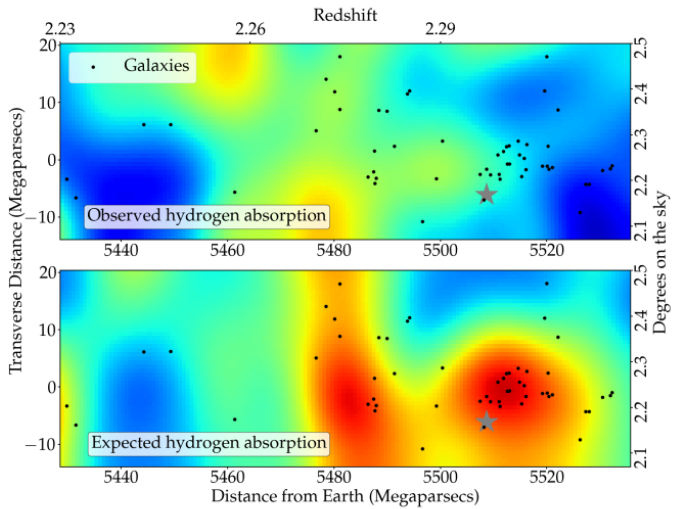According to a recent study published in The Astrophysical Journal Letters, an international team of researchers led by scientists at the Kavli Institute for the Physics and Mathematics of the Universe (Kavli IPMU) have discovered the earliest indication of regions of the universe that were heated to temperatures more characteristic of the intergalactic gas medium, where the majority of atoms in the universe currently reside.

This figure compares observed hydrogen absorption in vicinity of the COSTCO-I galaxy protocluster (top panel), compared with the expected absorption given the presence of the protocluster as computed from computer simulations. Strong hydrogen absorption is shown in red, lower while weak absorption is shown in blue, and intermediate absorption is denoted as green or yellow colors. The black dots in the figure show where astronomers have detected galaxies in that area. At the position of COSTCO-I (with its center marked as a star in both panels), astronomers found that the observed hydrogen absorption is not of much different from the mean value of the universe at that epoch. This is surprising because one would expect to find extended hydrogen absorption spanning millions of light years in that region corresponding to the high observed concentration of galaxies. This figure is adapted from the Dong et al. 2023 Astrophysical Journal Letters. Image Credit: Dong et al.
The intergalactic gas that covers vast stretches of space outside of visible galaxies contains around 90% of all atoms in the universe.
This intergalactic medium, which scientists frequently refer to as the “Warm-Hot Intergalactic Medium,” (WHIM), is currently in a heated, complicated state with temperatures ranging from 100,000 °C to more than 10 million °C.
However, more than 10 billion years ago, when galaxies in the universe were at their pinnacle of star formation, most of the intergalactic medium existed at comparatively colder temperatures of less than 10,000 °C, resulting in a more predictable and stable phase.
Researchers from across the world, led by graduate student Chenze Dong of Kavli IPMU and project assistant professor Khee-Gan Lee, have discovered the furthest region of the universe that saw temperatures closer to those of the current WHIM when the universe was just three billion years old.
This region is a massive collection of galaxies called “COSTCO-I,” a galaxy protocluster that spans millions of light years and has a total mass over 400 trillion times that of the Sun. It was also found in 2022 by Lee and a group of researchers from Kavli IPMU.
Even though galaxy protoclusters like this one are frequently observed in the furthest regions of the universe, the researchers noticed something peculiar when they examined the ultraviolet spectra of COSTCO-I using the 10.3 m diameter Keck-I Telescope at the W.M. Keck Observatory on Maunakea, Hawaii.
When observed at the particular wavelength of 121.6 nm, the vast mass and size of galaxy protoclusters would normally throw a massive shadow due to absorption by the neutral hydrogen associated with the protocluster gas.
However, no absorption shadow was discovered at COSTCO-I.
We were surprised at the absence because hydrogen absorption is one of the common ways to search for galaxy protoclusters, and other protoclusters near COSTCO-I do show this absorption signal.
Chenze Dong, Graduate Student, Kavli Institute for the Physics and Mathematics of the Universe, The University of Tokyo
The lack of neutral hydrogen tracing the protocluster suggests that the gas in the protocluster was heated to a million degrees above the cool state expected for the intergalactic medium at that time in the universe.
If we think about the present-day intergalactic medium as a gigantic cosmic stew that is boiling and frothing, then COSTCO-I is probably the first bubble in the distant past that astronomers have observed during an era while most of the pot was still cold.
Khee-Gan Lee, Project Assistant Professor, Kavli Institute for the Physics and Mathematics of the Universe, The University of Tokyo
Lee added, “The properties and origin of the WHIM remains one of the biggest questions in astrophysics right now, and to be able to glimpse at one of the early heating sites of the WHIM will help reveal the mechanisms that caused the intergalactic gas to boil up into the present-day froth. There are a few possibilities for how this can happen, but it might be either from gas heating up as they collide with each other during gravitational collapse, or giant radio jets might be pumping energy from supermassive black holes within the protocluster.”
Study co-author and JSPS Overseas Research Fellow Rieko Momose added, “The COSTCO-I is even interesting in terms of protocluster evolution. Astronomers normally look for protoclusters in galaxies or the intergalactic medium to find them. COSTCO-I, however, cannot be found by those traditional methods. The future PFS survey will be able to search for more such protoclusters, like COSTCO-I, and reveal their evolution.”
The intergalactic medium is the gas reservoir that supplies raw material to galaxies, and hot gas behaves differently than cold gas in terms of how quickly it can stream into galaxies and form stars.
The ability to directly see the expansion of the WHIM in the early cosmos would allow scientists to piece together a coherent picture of galaxy formation and the lifespan of the gas that feeds it.
Kavli IPMU scientists are now extensively involved in the creation of the Subaru Prime Focus Spectrograph (PFS), a powerful new multi-object spectrograph for the 8.2 m Subaru Telescope on Maunakea.
Astronomers will be able to map nearly 40 times larger volumes than in the current investigation and examine the gas characteristics in hundreds of galaxy protoclusters with Subaru PFS.
Journal Reference
Dong, C., et al. (2023) Observational Evidence for Large-scale Gas Heating in a Galaxy Protocluster at z = 2.30. The Astrophysical Journal Letters. doi:10.3847/2041-8213/acba89.